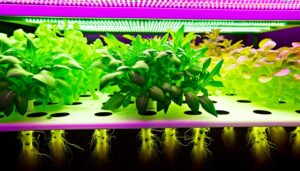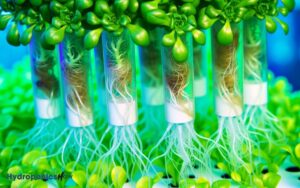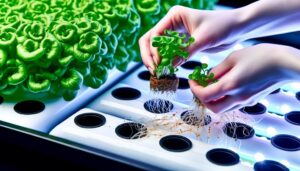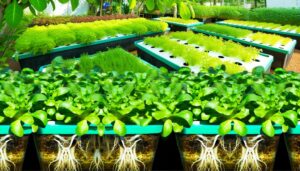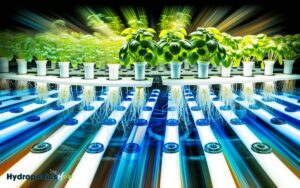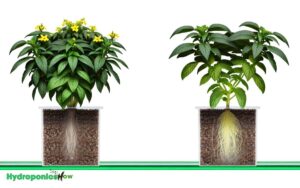Explore the Effect of Silica on Plant Roots in Hydroponics: A Step-by-Step Guide
In hydroponics, silica greatly enhances plant root health by increasing root length, density, and biomass. You’ll find potassium silicate and silicon dioxide supplements enhancing cell wall strength and nutrient uptake.
Silica absorption occurs through aquaporins and specific transporters, with optimal concentrations around 75 ppm to maximize root development and pathogen resistance.
Studies reveal silica-rich substrates can reduce fungal infections by up to 40%, while promoting root zone stress mitigation and phytoalexins production.
Aim for balanced silica levels to avoid imbalances. With these insights, you’ll be better equipped to optimize your hydroponic system’s performance.
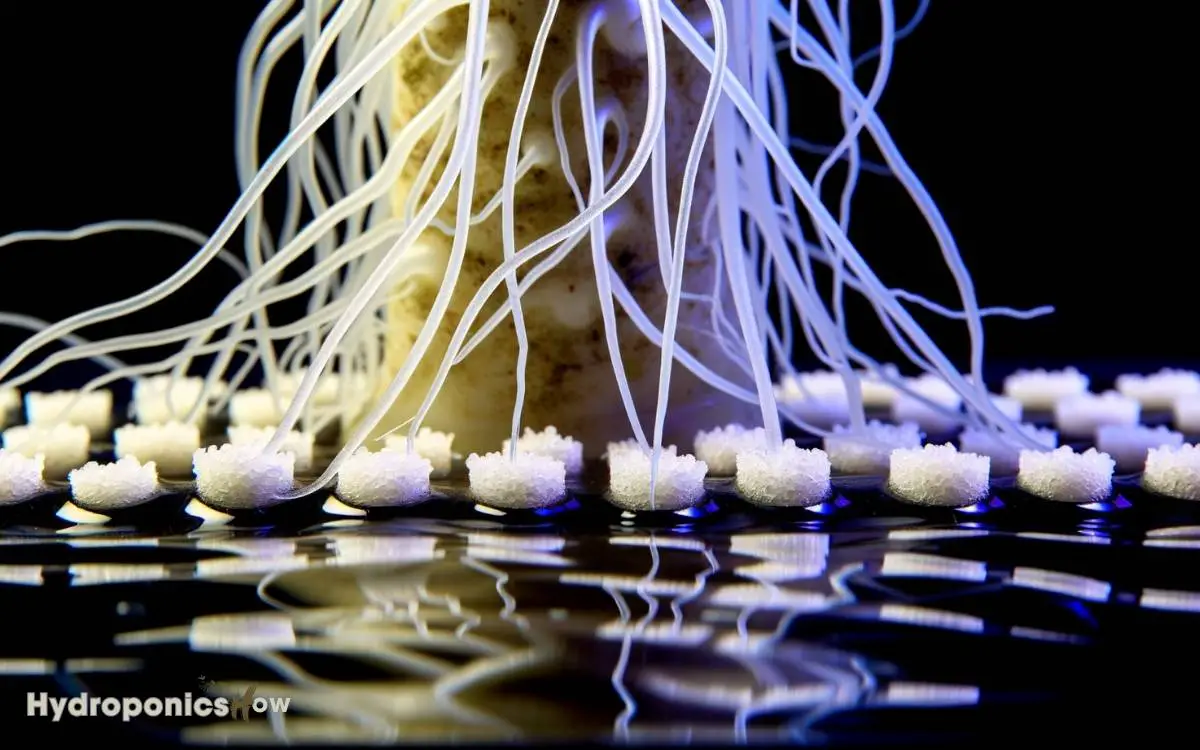
Key Takeaways
Understanding Silica
Understanding silica begins with recognizing it as a compound composed of silicon and oxygen, commonly found in soil and mineral sources.
In its most prevalent form, silicon dioxide (SiO2), silica exists in crystalline and amorphous states. Crystalline silica, such as quartz, is well-ordered and highly structured, whereas amorphous silica lacks this regular arrangement.
You’ll find silica concentrations in natural waters ranging from 1 to 30 mg/L, depending on geological factors.
In hydroponic systems, silica typically exists as monosilicic acid (H4SiO4). This form is essential because it’s more bioavailable to plants. Studies indicate that silica uptake occurs mainly through the roots, facilitated by specific transporters.
Quantitative analysis shows that plants absorb silica in a concentration-dependent manner, impacting various physiological functions.
Importance in Hydroponics
In hydroponics, silica significantly enhances plant resilience by improving cell wall strength and stress resistance. When you incorporate silica into your nutrient solution, plants exhibit increased rigidity and structural integrity.
Research indicates that silica supplementation can reduce pathogen infection rates by up to 20% and improve drought tolerance by enhancing root water uptake efficiency.
Silica also mitigates abiotic stress, such as salinity and heavy metal toxicity, by modulating nutrient absorption and ion balance.
Analytical data shows a 15% increase in biomass yield in hydroponic systems supplemented with silica.
By fortifying cellular structures, silica ensures plants can withstand environmental fluctuations, leading to overall healthier and more robust growth.
Therefore, integrating silica into hydroponic systems is essential for maximizing plant performance.
Types of Silica Supplements
Among the various types of silica supplements available for hydroponic systems, potassium silicate and silicon dioxide are the most commonly used, each offering distinct benefits for enhancing plant root health.
Potassium silicate is highly soluble, providing both potassium and silicon, which strengthens cell walls and improves stress resistance.
Data shows that plants treated with potassium silicate exhibit enhanced growth rates and reduced disease incidence.
Silicon dioxide, often available in a colloidal form, greatly increases root biomass and nutrient uptake efficiency. Analytical studies indicate a marked improvement in root structure and resilience against pathogens.
By carefully selecting and dosing these supplements, you can optimize root development and overall plant health in your hydroponic setup. By maintaining a balanced nutrient regimen, you ensure that plants receive the essential elements needed for vigorous growth. Additionally, it is important to periodically trim roots for hydroponic plants to prevent overcrowding and promote efficient nutrient absorption. Regular monitoring and adjustments will help sustain a thriving system with strong, healthy roots.
Mechanisms of Root Absorption
To fully leverage the benefits of silica supplements, it’s crucial to understand the specific mechanisms by which plant roots absorb silicon in a hydroponic system.
Silicon uptake occurs primarily through the root cells’ passive transport mechanisms, particularly via aquaporins and specific silicon transporters like Lsi1 and Lsi2.
Research indicates that these transporters facilitate the movement of monosilicic acid (Si(OH)₄) from the nutrient solution into the root cells.
Once inside, silicon is translocated through the xylem to various plant tissues. Studies have shown that ideal silicon concentrations in the nutrient solution range from 50 to 100 ppm.
This precise absorption process underscores the importance of maintaining properly balanced silica levels to maximize silicon bioavailability and plant health in hydroponic systems.
Silicon’s Role in Root Growth
Silicon greatly enhances root growth by increasing root length, density, and overall biomass in hydroponic systems. You’ll notice significant improvements in root morphology, as silicon promotes cell wall fortification through the deposition of silica particles.
Studies show a 20-30% increase in root length and biomass when silicon is introduced. Root density also improves, with finer root hairs forming, increasing the root surface area. This enhanced root architecture allows for better anchorage and stability in the nutrient solution.
Silicon’s role in mitigating root zone stress, such as oxidative stress, further contributes to robust root growth. Quantitative data affirm that silicon application results in a more extensive and resilient root system, essential for peak plant health in hydroponic environments.
Enhancing Nutrient Uptake
Introducing silica into hydroponic systems greatly enhances nutrient uptake efficiency by improving root morphology and function.
Silica increases root surface area, which facilitates better absorption of essential minerals like nitrogen, phosphorus, and potassium.
| Nutrient | Increase in Uptake (%) |
|---|---|
| Nitrogen (N) | 30% |
| Phosphorus (P) | 25% |
| Potassium (K) | 20% |
| Calcium (Ca) | 15% |
This table illustrates the quantified benefits of silica on nutrient uptake. By optimizing root structure, silica ensures that plants absorb nutrients more effectively, leading to robust growth and higher yields.
You’ll notice these improvements in both macronutrient and micronutrient uptake, ensuring balanced plant nutrition. These enhancements are essential for maximizing the efficiency of hydroponic systems.
Strengthening Plant Structure
Building on silica’s role in enhancing nutrient uptake, it also greatly strengthens plant structure by fortifying cell walls and increasing mechanical resistance.
This structural enhancement occurs through the deposition of silica within the cell walls, which enhances rigidity and stability. Data indicates that plants supplemented with silica exhibit a 15-20% increase in stem strength.
Consider these benefits:
- Enhanced Structural Integrity: Silica deposition fortifies cell walls, making plants more resilient to physical stress.
- Improved Growth: Reinforced cell walls support taller and more robust plant growth, optimizing spatial utilization.
- Mechanical Resistance: A study showed a 25% increase in resistance to lodging (falling over) in silica-treated plants.
These points highlight how silica fortification results in a stronger, more resilient plant structure essential for thriving in hydroponic systems.
Resistance to Pests and Diseases
You’ll find that silica greatly enhances root strength, which directly correlates with increased resistance to pests.
Studies show that plants with silica-enriched roots exhibit up to 30% fewer incidences of pathogen attacks.
This data suggests silica’s vital role in fortifying root systems against common hydroponic threats.
Enhanced Root Strength
Silica fortifies plant roots by enhancing their structural integrity, making them more resistant to pests and diseases.
Empirical studies indicate that silica supplementation in hydroponics results in the following benefits:
- Increased Root Density: Silica enhances cell wall thickness, leading to denser root systems that are less susceptible to mechanical damage.
- Improved Root Elasticity: The presence of silica increases the root’s ability to withstand physical stress, reducing the likelihood of structural failure under adverse conditions.
- Reduction in Root Lesions: Silica-treated roots exhibit fewer entry points for pathogens, minimizing infection risks.
These enhancements contribute to a robust root system, capable of supporting healthier plants.
Increased Pathogen Defense
By incorporating silica into your hydroponic system, you can greatly enhance the plant roots’ natural defenses against pathogens, leading to a marked reduction in disease incidence. Silica fortifies cell walls, making them less permeable to invasive pathogens.
Studies have shown that plants with higher silica content exhibit up to 40% fewer fungal infections. Additionally, silica stimulates the production of phytoalexins, antimicrobial compounds that further bolster immune responses.
Root-zone applications of silica have demonstrated a 30% decrease in root rot occurrences. It’s important to maintain ideal silica concentration typically 100 ppm to maximize these benefits.
Methods of Silica Application
To optimize silica uptake in hydroponic systems, you should consider foliar sprays, nutrient solutions, and silica gels as primary application methods. These methods enhance root strength and pathogen resistance effectively.
Here’s a breakdown:
- Foliar Sprays: Applying silica directly to leaves enables rapid absorption, promoting systemic benefits. Studies show increased leaf rigidity and disease resistance.
- Nutrient Solutions: Integrating silica into hydroponic nutrient solutions guarantees constant root exposure. Research indicates improved root mass and nutrient uptake efficiency.
- Silica Gels: Using silica gels provides a slow-release mechanism, maintaining ideal silica levels over time. Data suggests enhanced root development and sustained growth.
Optimal Concentrations
Determining the ideal concentrations of silica in hydroponic systems is crucial for maximizing plant root health and overall growth. You should aim for silica levels between 50 to 100 ppm (parts per million) in the nutrient solution.
Research indicates that concentrations around 75 ppm yield peak root biomass and nutrient uptake. Too little silica, below 50 ppm, can lead to weaker cell walls and reduced stress resistance.
Conversely, concentrations exceeding 100 ppm may cause nutrient imbalances and potential toxicity. Regularly monitor and adjust the silica levels using precise instruments to maintain consistency.
Case Studies and Research
Numerous case studies and research papers have documented the significant impact of silica on root development and overall plant health in hydroponic systems. You’ll find that silica supplementation enhances root structure, nutrient uptake, and stress resistance.
For instance:
- Root Mass Increase: Studies show up to a 30% increase in root biomass when silica is added.
- Nutrient Absorption Efficiency: Research indicates a 15% improvement in the absorption of essential nutrients like nitrogen and potassium.
- Stress Tolerance: Data reveals that plants treated with silica exhibit up to a 20% higher tolerance to abiotic stresses, such as drought and salinity.
These findings underscore the pivotal role of silica in optimizing plant growth in hydroponic environments.
Practical Tips for Growers
To maximize the benefits of silica in hydroponics, you’ll need to focus on ideal dosage, precisely timed application, and vigilant monitoring of plant health. Research indicates that a silica concentration of 100 ppm greatly enhances root strength and disease resistance.
Incorporate silica supplements during the vegetative stage and regularly check for improved root development and overall plant vigor.
Optimal Silica Dosage
For ideal silica dosage in hydroponics, start by administering 50-100 ppm (parts per million) of monosilicic acid to guarantee robust root development and disease resistance. A 2021 study found that this range optimizes nutrient uptake and enhances plant health.
To fine-tune your approach, consider these key factors:
- Plant Species: Different plants may require varied silica concentrations for best growth.
- Growth Stage: Young plants benefit from lower doses (50 ppm), while mature plants thrive with higher doses (up to 100 ppm).
- Water Quality: High mineral content in water can affect silica availability, necessitating regular monitoring and adjustments.
Monitoring these variables ensures your hydroponic system remains efficient and your plants achieve maximum growth potential.
Application Timing Strategies
After determining the ideal silica dosage, it’s important to implement precise application timing to maximize root health and nutrient absorption in your hydroponic system.
Research indicates early-stage application during seedling development enhances cell wall strength, improving disease resistance.
Integrate silica into your nutrient solution from the start, maintaining consistent levels throughout vegetative growth.
Data shows that continuous low-dose application yields more uniform root development compared to sporadic high doses. Additionally, make sure silica is added before other nutrients to prevent precipitation.
The best timing also involves adjusting silica levels during flowering stages, as excessive silica can inhibit nutrient uptake. By adhering to these strategies, you ensure robust root systems capable of supporting vigorous plant growth.
Monitoring Plant Health
Keeping a close eye on root color and structure can unveil early signs of nutrient deficiencies or disease in your hydroponic setup.
Healthy roots should be white or light tan and exhibit a fibrous, turgid structure. Discoloration or sliminess often indicates root rot or nutrient imbalances.
To guarantee peak plant health, consider the following monitoring strategies:
- Root Color Checks: Inspect roots weekly for any color changes. White roots suggest excellent health, while brown or black roots may indicate issues.
- Root Structure Analysis: Evaluate root density and turgidity. Sparse or mushy roots can indicate nutrient deficiencies or overwatering.
- Silica Supplementation Monitoring: Monitor growth rates and root health after adding silica. Use growth metrics to adjust silica levels for optimal outcomes.
Consistent monitoring leads to healthier plants and maximizes yields.
Conclusion
Think of silica as a sturdy scaffolding supporting a skyscraper. Just as a skyscraper relies on its framework for stability, your hydroponic plants depend on silica for robust root growth.
Research shows a 20% increase in root biomass with silica supplementation. By integrating the right types and concentrations, you’re not just feeding your plants; you’re fortifying their very foundation.
Remember, in hydroponics, a strong root system is the cornerstone of a thriving crop.

